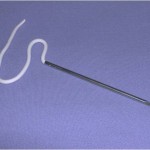As of today, there are seven commercially-available injectable fillers, from the original Restylane (hyaluronic acid) to the most recent ArteFill (plastic microspheres). While these all produce wonderful and instantaneous results in the filling of facial lines, wrinkles, and lips, the lifespan of their effect is limited to montsh and, at best, certainly less than one year. Some injected patients ultimately tire of the injection process and desire a more permanent solution to their facial problems, even if it requires surgery to do so. Once a patient reaches this ‘qualified’ level, there is a permanent filling solution (Advanta Facial Implants) for the selected areas of the lips, nasolabial folds, marionette lines, and the glabellar furrows. (the famous 11s between the eyebrows) Because they are not new and are produced by a company whose main revenues come from vascular grafts, these permanent facial implants have not caught a lot of press and most patients are completely unaware of them. I have used them for the past 5 years with great success and very few problems. For the right patient who desires to move on from temporary fillers and can accept having a permanent implant under their skin, these type implants are a good treatmenmt option to consider.
Advanta Facial Implants represent a major advance in PTFE (Gore-tex) implant technology. Advanta is the first “next generation” PTFE implant material to feature innovative biocompatible architecture combining a soft central core with a controlled cellular penetration outer layer. This unique one-piece construction offers patients a softer, more aesthetic and more comfortable implant with a more natural look and feel. The soft central core allows increased cellular interaction and vascularization, with reduced inflammation. Patients may experience less rigid encapsulation or “walling off”, resulting in a softer, more natural healing response. This controlled cellular penetration also enhances implant stabilization and may help reduce the risk of migration and extrusion.
These implants can be placed under local anesthesia in the office. They are threaded into place by a tiny incision on each end of the treated area. Through an attached needle, they are threaded into placed, the ends trimmed, and one small stitch placed to close the small entry and exit holes. There are numerous different sizes available in either a round or oval form. Like temporary injectable fillers, the result is instantaneous. Unlike temporary injectable fillers, there will be some swelling and bruising for a few days after the procedure. The greatest advantage to this type of subcutaneous facial implant is that they provide a permanent treatment for soft tissue folds and deficiences, primarily of the nasolabial folds and the lips.
Dr Barry Eppley
Indianapolis



